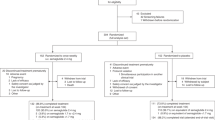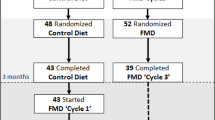Abstract
Objective:
As more and more postmenopausal women are taking soy isoflavone supplementation for relieving menopausal symptoms, we investigated the impact of chronic exposure on their bioavailability, with focus on achievable plasma concentrations and potential stimulation of the capacity to produce equol.
Subjects:
A total of 12 Caucasian postmenopausal women.
Intervention:
Volunteers ingested 100 mg isoflavones/day (aglycone equivalents, in cereal bars and yoghurts) for 1 month. Plasma concentrations of metabolites at 2, 4, 6, 8, 10, 12 and 24 h postdose, as well as urinary excretion in fractions over 36 h were compared between days 1 and 30.
Results:
Similar plasma kinetic curves were obtained at day 1 and day 30 for genistein and daidzein. Maximum plasma concentrations were 1.68±0.68 μmol/l on day 1 compared to 2.27±0.76 μmol/l on day 30 for daidzein (P=0.056), and 3.88±1.50 μmol/l on day 1 compared to 5.30±2.38 μmol/l on day 30 for genistein (P=0.091). Urinary excretion of daidzein and genistein did not differ significantly between days 1 and 30. Maximum plasma concentration of equol increased significantly from 0.31±0.27 to 0.99±0.51 μmol/l for equol-producer volunteers (P=0.046). However, the seven volunteers who were classified as non-equol producers on day 1 did not acquire the ability to produce equol after 1-month exposure.
Conclusions:
Chronic exposure to isoflavones in postmenopausal women resulted in plasma concentrations as high as 2.5–5 μmol/l of each isoflavone, but did not induce the ability to produce equol.
Sponsorship:
French Ministry of Research (AQS program A01347) and Beghin-Meiji (doctoral fellowship).
This is a preview of subscription content, access via your institution
Access options
Subscribe to this journal
Receive 12 print issues and online access
$259.00 per year
only $21.58 per issue
Buy this article
- Purchase on Springer Link
- Instant access to full article PDF
Prices may be subject to local taxes which are calculated during checkout


Similar content being viewed by others
References
Adlercreutz H, Honjo H, Higashi A, Fotsis T, Hämäläinen E, Hasegawa T et al. (1991). Urinary excretion of lignans and isoflavonoid phytoestrogens in Japanese men and women consuming a traditional Japanese diet. Am J Clin Nutr 54, 1093–1100.
Akaza H, Miyanaga N, Takashima N, Naito S, Hirao Y, Tsukamoto T et al. (2004). Comparisons of percent equol producers between prostate cancer patients and controls: case-controlled studies of isoflavones in Japanese, Korean and American residents. Jpn J Clin Oncol 34, 86–89.
Atkinson C, Berman S, Humbert O, Lampe JW (2004). In vitro incubation of human feces with daidzein and antibiotics suggests interindividual differences in the bacteria responsible for equol production. J Nutr 134, 596–599.
Bonorden MJ, Greany KA, Wangen KE, Phipps WR, Feirtag J, Adlercreutz H et al. (2004). Consumption of Lactobacillus acidophilus and Bifidobacterium longum do not alter urinary equol excretion and plasma reproductive hormones in premenopausal women. Eur J Clin Nutr 58, 1635–1642.
Boulet MJ, Oddens BJ, Lehert P, Vemer HM, Visser A (1994). Climacteric and menopause in 7 South-East Asian Countries. Maturitas 19, 157–176.
Decroos K, Vanhemmens S, Cattoir S, Boon N, Verstraete W (2005). Isolation and characterisation of an equol-producing mixed microbial culture from a human faecal sample and its activity under gastrointestinal conditions. Arch Microbiol 183, 45–55.
Duncan AM, MerzDemlow BE, Xu X, Phipps WR, Kurzer MS (2000). Premenopausal equol excretors show plasma hormone profiles associated with lowered risk of breast cancer. Cancer Epidemiol Biomarkers Prev 9, 581–586.
Erdman Jr JW, Badger TM, Lampe JW, Setchell KD, Messina M (2004). Not all soy products are created equal: caution needed in interpretation of research results. J Nutr 134, 1229S–1233S.
Frankenfeld CL, Atkinson C, Thomas WK, Goode EL, Gonzalez A, Jokela T et al. (2004). Familial correlations, segregation analysis, and nongenetic correlates of soy isoflavone-metabolizing phenotypes. Exp Biol Med 229, 902–913.
Hedlund TE, Maroni PD, Ferucci PG, Dayton R, Barnes S, Jones K et al. (2005). Long-term dietary habits affect soy isoflavone metabolism and accumulation in prostatic fluid in Caucasian men. J Nutr 135, 1400–1406.
Hur HG, Lay JO, Beger RD, Freeman JP, Rafii F (2000). Isolation of human intestinal bacteria metabolizing the natural isoflavone glycosides daidzin and genistin. Arch Microbiol 174, 422–428.
Jordan VC (2004). Selective estrogen receptor modulation: concept and consequences in cancer. Cancer Cell 5, 207–213.
Karr SC, Lampe JW, Hutchins AM, Slavin JL (1997). Urinary isoflavonoid excretion in humans is dose dependent at low to moderate levels of soy-protein consumption. Am J Clin Nutr 66, 46–51.
Kelly GE, Nelson C, Waring MA, Joannou GE, Reeder AY (1993). Metabolites of dietary (soya) isoflavones in human urine. Clin Chim Acta 223, 9–22.
Lampe JW, Karr SC, Hutchins AM, Slavin JL (1998). Urinary equol excretion with a soy challenge: influence of habitual diet. Proc Soc Exp Biol Med 217, 335–339.
Lampe JW, Skor HE, Li S, Wahala K, Howald WN, Chen C (2001). Wheat bran and soy protein feeding do not alter urinary excretion of the isoflavan equol in premenopausal women. J Nutr 131, 740–744.
Lu LJ, Lin SN, Grady JJ, Nagamani M, Anderson KE (1996). Altered kinetics and extent of urinary daidzein and genistein excretion in women during chronic soya exposure. Nutr Cancer 26, 289–302.
Lu LLW, Grady JJ, Marshall MV, Ramanujam VMS, Anderson KE (1995). Altered time course of urinary daidzein and genistein excretion during chronic soya diet in healthy male subjects. Nutr Cancer 24, 311–323.
Lydeking-Olsen E, Beck-Jensen JE, Setchell KD, Holm-Jensen T (2004). Soymilk or progesterone for prevention of bone loss – a 2 year randomized, placebo-controlled trial. Eur J Nutr 43, 246–257.
Magee PJ, Rowland IR (2004). Phyto-oestrogens, their mechanism of action: current evidence for a role in breast and prostate cancer. Br J Nutr 91, 513–531.
Manach C, Williamson G, Morand C, Scalbert A, Remesy C (2005). Bioavailability and bioefficacy of polyphenols in humans. I. Review of 97 bioavailability studies. Am J Clin Nutr 81, 230S–242S.
Messina MJ (2003). Emerging evidence on the role of soy in reducing prostate cancer risk. Nutr Rev 61, 117–131.
Meyer BJ, Larkin TA, Owen AJ, Astheimer LB, Tapsell LC, Howe PR (2004). Limited lipid-lowering effects of regular consumption of whole soybean foods. Ann Nutr Metab 48, 67–78.
Miltyk W, Craciunescu CN, Fischer L, Jeffcoat RA, Koch MA, Lopaczynski W et al. (2003). Lack of significant genotoxicity of purified soy isoflavones (genistein, daidzein, and glycitein) in 20 patients with prostate cancer. Am J Clin Nutr 77, 875–882.
Mishra SI, Dickerson V, Najm W (2003). Phytoestrogens and breast cancer prevention: what is the evidence? Am J Obstet Gynecol 188 (Suppl), S66–S70.
Miyanaga N, Akaza H, Takashima N, Nagata Y, Sonoda T, Mori M et al. (2003). Higher consumption of green tea may enhance equol production. Asian Pac J Cancer Prev 4, 297–301.
Morton MS, Arisaka O, Miyake N, Morgan LD, Evans BA (2002). Phytoestrogen concentrations in serum from Japanese men and women over forty years of age. J Nutr 132, 3168–3171.
Nettleton JA, Greany KA, Thomas W, Wangen KE, Adlercreutz H, Kurzer MS (2004). Plasma phytoestrogens are not altered by probiotic consumption in postmenopausal women with and without a history of breast cancer. J Nutr 134, 1998–2003.
Ohta A, Uehara M, Sakai K, Takasaki M, Adlercreutz H, Morohashi T et al. (2002). A combination of dietary fructooligosaccharides and isoflavone conjugates increases femoral bone mineral density and equol production in ovariectomized mice. J Nutr 132, 2048–2054.
Rowland IR, Wiseman H, Sanders TAB, Adlercreutz H, Bowey EA (2000). Interindividual variation in metabolism of soy isoflavones and lignans: influence of habitual diet on equol production by the gut microflora. Nutr Cancer 36, 27–32.
Setchell KD, Borriello SP, Hulme P, Kirk DN, Axelson M (1984). Nonsteroidal estrogens of dietary origin: possible roles in hormone-dependent disease. Am J Clin Nutr 40, 569–578.
Setchell KD, Brown NM, Desai P, Zimmer-Nechemias L, Wolfe BE, Brashear WT et al. (2001). Bioavailability of pure isoflavones in healthy humans and analysis of commercial soy isoflavone supplements. J Nutr 131 (Suppl), 1362S–1375S.
Setchell KD, Brown NM, Lydeking-Olsen E (2002). The clinical importance of the metabolite equol-a clue to the effectiveness of soy and its isoflavones. J Nutr 132, 3577–3584.
Ueno T, Uchiyama S (2001). Identification of the specific intestinal bacteria capable of metabolising soy isoflavone to equol. Ann Nutr Metab 45, 114.
Wang XL, Hur HG, Lee JH, Kim KT, Kim SI (2005). Enantioselective synthesis of S-equol from dihydrodaidzein by a newly isolated anaerobic human intestinal bacterium. Appl Environ Microbiol 71, 214–219.
Wiseman H, Casey K, Bowey EA, Duffy R, Davies M, Rowland IR et al. (2004). Influence of 10 wk of soy consumption on plasma concentrations and excretion of isoflavonoids and on gut microflora metabolism in healthy adults. Am J Clin Nutr 80, 692–699.
Zafar TA, Weaver CM, Jones K, Moore II DR, Barnes S (2004). Inulin effects on bioavailability of soy isoflavones and their calcium absorption enhancing ability. J Agric Food Chem 52, 2827–2831.
Zubik L, Meydani M (2003). Bioavailability of soybean isoflavones from aglycone and glucoside forms in American women. Am J Clin Nutr 77, 1459–1465.
Acknowledgements
This work was supported in part by the French Ministry of Research (AQS program A01347) and Beghin-Meiji (doctoral fellowship). We are grateful to Eridania Beghin-Say and Beghin-Meiji for kindly supplying the powdered isoflavone concentrate (Prevastein ®HC).
Author information
Authors and Affiliations
Corresponding author
Rights and permissions
About this article
Cite this article
Védrine, N., Mathey, J., Morand, C. et al. One-month exposure to soy isoflavones did not induce the ability to produce equol in postmenopausal women. Eur J Clin Nutr 60, 1039–1045 (2006). https://doi.org/10.1038/sj.ejcn.1602415
Received:
Revised:
Accepted:
Published:
Issue Date:
DOI: https://doi.org/10.1038/sj.ejcn.1602415
Keywords
This article is cited by
-
Does equol production determine soy endocrine effects?
European Journal of Nutrition (2012)
-
Urinary phytoestrogens and risk of prostate cancer in Jamaican men
Cancer Causes & Control (2010)
-
Daidzein-metabolizing phenotypes in relation to mammographic breast density among premenopausal women in the United States
Breast Cancer Research and Treatment (2009)



